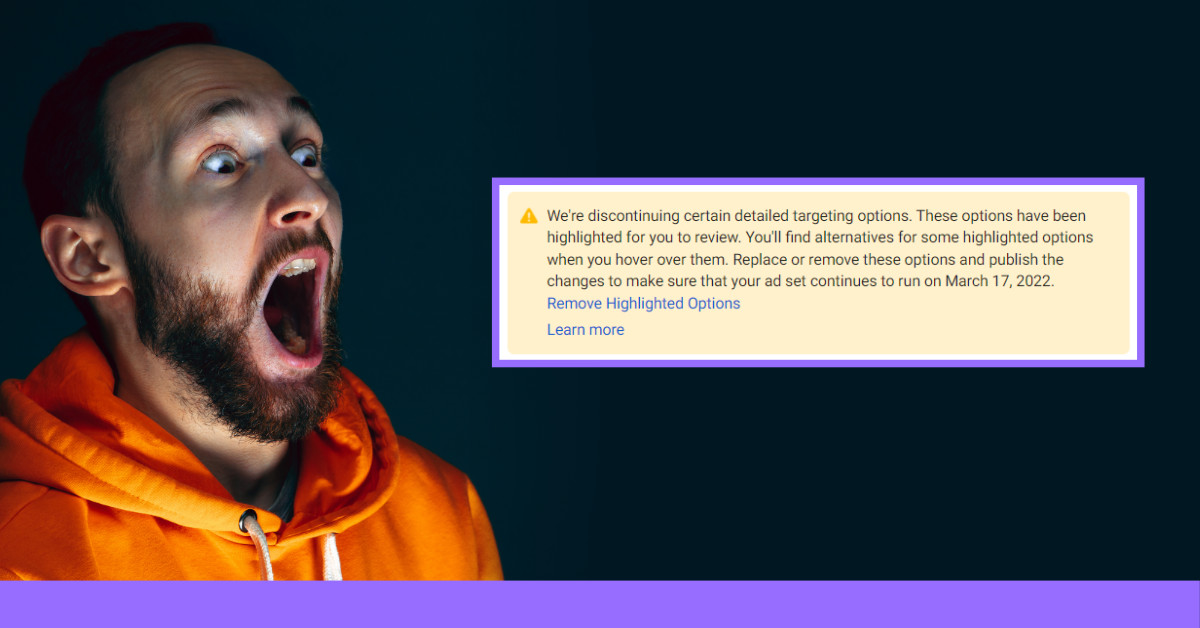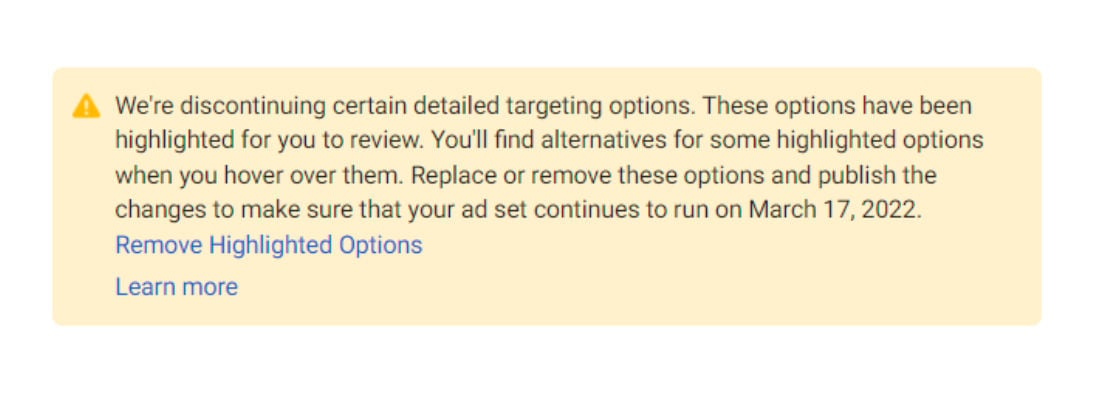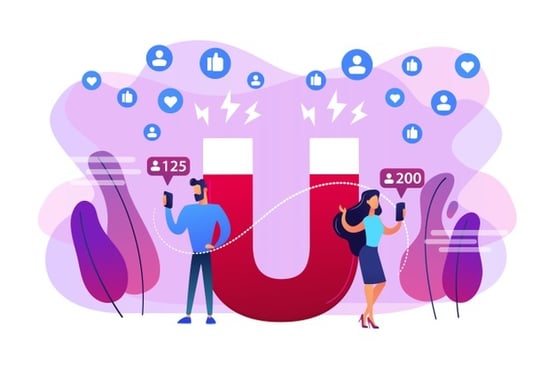Interest targeting on Facebook Ads: time to move beyond

Facebook Ads is increasingly limiting the detailed targeting options available to advertisers. Is it time to change how we advertise? Maybe so, here's why.
Direct Read:
What detailed targeting isNew limitations on interest targeting in Facebook Ads
Changes with the update
Overcoming the challenge
To conclude
Despite an ever-evolving landscape and the daily emergence of new tools, the bulk of digital advertising investments (at least in the "Western" world) are made on two platforms: Google Ads and Facebook Ads. It's noteworthy that in 2021, around $50.3 billion was spent on Facebook Ads in the US market alone. Given these volumes, developments on these platforms could likely herald broader shifts within the entire sector or even steer and shape its direction.
What is Detailed Targeting?
For the uninitiated, detailed targeting allows advertisers to refine their audiences on Facebook Ads based on additional demographic criteria, behaviors, and interests. This feature is extensively utilized by advertisers because it enables more precise targeting of advertising investments, whether for top-of-the-funnel activities (e.g., brand awareness campaigns) or for pursuing acquisition goals (e.g., lead generation or e-commerce), involving cold audiences.
New Limitations on Interest Targeting in Facebook Ads
In January 2022, shortly after returning to the office, my colleagues in the media planning team at AND EMILI and I encountered an unwelcome surprise. And I'm sure that anyone working daily on Facebook Ads would have preferred to avoid it too. A notification within many of our campaign settings announced, "We're discontinuing certain detailed targeting options [...] March 17, 2022."

Effectively, the detailed targeting capabilities offered by Facebook Ads are diminishing. Here's Meta's note on the ongoing updates, which will be fully implemented by March 17. We have seen similar updates before, but the options now seem to be reducing drastically based on our current campaign management experiences.
Implications of the Ongoing Update

A considerable number of targeting criteria will no longer be available. For instance, where we could previously target ads to users specifically interested in "soil cultivation" or "plows" rather than broadly those interested in agriculture, such specificity will no longer be possible from March.
Meta has stated that this decision affects options "not widely used or related to topics that people might perceive as sensitive." It's clear that the platform has been signaling, more or less explicitly, a move beyond this type of audience construction. An example is the increasing push towards the detailed targeting expansion option, strongly recommended during Facebook Marketing Experts consulting sessions and set by default when duplicating an ad group. Moreover, accessing specific interest segmentation criteria for sensitive topics had already become impossible.
Regardless of the reasons behind this decision, I believe the impact on advertising methods and the return on advertising investments for many advertisers will be significant.
In my opinion, as long as we're discussing B2C companies offering mass-market products already accustomed to substantial digital channel investments, not much may change. However, for companies operating in very specific niches, certainly in the B2B realm, I'm confident the effects of the update will be palpable.
Overcoming the Challenge
 Essentially, Meta recommends adopting a more "fluid" approach by, on one hand, utilizing alternative targeting criteria such as custom audiences or lookalike audiences, and on the other, allowing the system itself to find the most suitable users through broad targeting (age, gender, location) and targeting expansions (detailed and lookalike audiences).
Essentially, Meta recommends adopting a more "fluid" approach by, on one hand, utilizing alternative targeting criteria such as custom audiences or lookalike audiences, and on the other, allowing the system itself to find the most suitable users through broad targeting (age, gender, location) and targeting expansions (detailed and lookalike audiences).
Aware that broad targeting would be unthinkable and unsustainable for many companies, the need to work with custom audiences and proprietary data becomes increasingly evident. However, to make this feasible, it will be necessary to increase investments in awareness and, more broadly, plan actions aimed at the top of the funnel. Let’s explore how.
Follower Base
 Users interacting with a brand's social channels form an invaluable base for digital marketing actions. Unfortunately, the organic visibility of content published through business accounts is significantly reduced today. As a result, implementing a strategy dedicated to capturing new fans/followers to build an ever-expanding base proves to be a winning choice for several reasons, primarily:
Users interacting with a brand's social channels form an invaluable base for digital marketing actions. Unfortunately, the organic visibility of content published through business accounts is significantly reduced today. As a result, implementing a strategy dedicated to capturing new fans/followers to build an ever-expanding base proves to be a winning choice for several reasons, primarily:
- Enhancing the potential organic reach of our content, thereby maximizing the return on investments made in the operational management of the channels in terms of time and resources;
- The ability to target the most engaged followers or those who have shown explicit interest (interaction) in our content over a defined period.
Video Viewers
It's no secret that videos are among the most appreciated formats on social networks, and for some of the major platforms, they are even the only possible format (YouTube, TikTok). Besides being an effective type of content for any marketing objective, videos offer technical advantages that other types of content cannot provide on Facebook Ads, advantages also due to the fact that engagement with them occurs directly on the platform. For example:
- retrieving users lost due to opt-outs from third-party cookie tracking and updates to iOS 14 and later;
- the possibility to build audiences at different levels of profiling, based on the type of video viewed and the percentage of completion.
Website and App Visitors
 We often tend to forget, but our website is the digital tool over which we have the greatest control, and generally, it's where most of the value we can transfer to users resides. The same generally applies to our proprietary apps.
We often tend to forget, but our website is the digital tool over which we have the greatest control, and generally, it's where most of the value we can transfer to users resides. The same generally applies to our proprietary apps.
Implementing effective tracking of websites and apps through tools provided by Facebook Ads (Facebook Pixel, Facebook SDK, Conversion API) will ensure access to very advanced targeting - and retargeting - levels. Moreover, acquiring traffic to these assets should be a constant goal to pursue throughout the year with dedicated budgets, so as to have adequately large audiences available for use during promotional campaigns or for lead generation.
Customer Lists
 CRM systems, mailing platforms, marketing automation, and inbound marketing ecosystems: all those systems directly managed by our company from which we can generate segmented lists of prospects and customers (ensuring we have the authorization!) constitute the best data source our company could wish for. Data that is just waiting to be utilized. And quite easily, if we consider the customer list upload functions available on Facebook Ads, as well as on other platforms like Google Ads or LinkedIn Ads.
CRM systems, mailing platforms, marketing automation, and inbound marketing ecosystems: all those systems directly managed by our company from which we can generate segmented lists of prospects and customers (ensuring we have the authorization!) constitute the best data source our company could wish for. Data that is just waiting to be utilized. And quite easily, if we consider the customer list upload functions available on Facebook Ads, as well as on other platforms like Google Ads or LinkedIn Ads.
In Conclusion
In a way, the assets we own are regaining value and, in my opinion, will continue to increase in importance. Our website, mobile apps, social media pages, the videos we produce, and the data we can extract from our CRM...these are the sources we need to nurture in the coming years because they will enable our ability to plan effective advertising campaigns, overcoming, whether we like it or not, the good old interest targeting.
Is interest targeting dying? How are you preparing for the new limitations? Feel free to leave a comment if you’d like 😉
This page has been translated using automated translation tools and artificial intelligence technologies. We strive to ensure that the content is accessible in multiple languages, but please be aware that the translation may not be perfect. If you have any doubts or need clarifications, please feel free to contact us.

